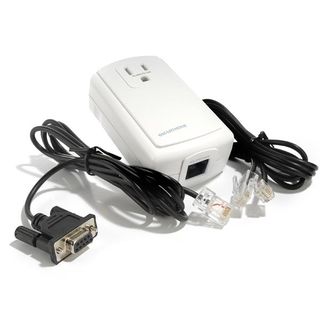I have an extensive home automation implementation that I have built over the years based, for the most part, on Insteon technology. I recently decided that I wanted to integrate my Ademco security system into my setup so I could take advantage of its vast array of sensors.
I have been using an ISY-99i controller module and an Smarthome 2412S PLM to drive my Insteon network and have been pretty happy with that configuration. One of the main attractions of the ISY-99i appliance is the fact that it can stand alone, without the need for a computer. Since hacking my security panel into my system will require a computer to drive the programming interface, the ISY-99i starts to loose its appeal.
Since I already have a Mac machine that serves up files and other services in the house, I thought I would go ahead and use that box to power the Ademco interface as well as take over the management of my Insteon network. My preference would be to use an opensource project like Misterhouse to drive my solution but for a number of reasons, I decided to investigate the Indigo solution from Perceptive Automation.
The first step to investigating the Indigo Software was to interface my Mac, running Snow Leopard, to my Insteon Network. Since the 2412S PLM is a serial device and Mac computers do not ship with serial ports, you have to find a way to make the two talk to one another. The Indigo online manual provides some very helpful information on interfaces. Since I already have a 2412S PLM, that will be my interface of choice.

As stated in the help document, it will also be necessary to use a USB to Serial adapter to connect the PLM’s RJ-45 to 6-Conductor cable to a USB port on the Mac. I was pretty certain that I had seen a USB to Serial adapter on the shelf at my local Best Buy, so I started there. Sure enough, there was an overpriced ($37) Dynex DX-UBDB9 adapter sitting on the shelf. Since I had the free time to work on the project right then and not a few days later, I decided to buy the unit even though I could have ordered one (or parts to build my own) for a fraction of the price elsewhere.

I unboxed the adapter and attached it to my computer and the PLM and was hoping that OS/X would see the device and just work. Unfortunately it did not. The disk that came with the device only contained Windows drivers so I started searching the web. I found a Mac driver on the manufactures website but it didn’t work. I also found a driver on the Apple support forum but that driver didn’t work either. I noticed that the Indigo help document referenced the FTDI Virtual COM Port driver for USB to Serial connectivity on the Mac. My next thought was to try that, but again, no good.
At this point I began to suspect that there might be an incompatibility between my adapter and OS/X. I opened up System Profiler to see if my Mac was seeing anything on the USB Bus that might be helpful. Right away I noticed that the chipset on my adapter was different than expected and upon further investigation learned that their are two primary chipsets used on USB to Serial adapters. One of those chipsets is by Future Technology Devices International, referenced above, the other is from Prolific Technology and, as it turns out, is the maker of the chipset in my Dynex Device. After more trial and error, I finally came across a project on github that updated the Mac driver for the Prolific 2303 chipset to work on OS/X Snow Leopard.
I downloaded the driver package and installed it on my machine and I immediately saw a new device that was referenceable by Indigo!
Now that I can see the PLM via Indigo, I will need to perform extensive testing to ensure that the COM driver is reliable while also ensuring that Indigo will meet my needs as a replacement engine for my Insteon network as well as provide a suitable interface to my Ademco panel.
Until next time … geek out!
~GT~
